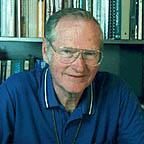
Specialization:
Inorganic/Analytical Chemistry
Bio:
Dr. Kennedy received his Ph.D. from Harvard University in 1957. After holding positions as research chemist at duPont and General Motors, he joined the UCSB faculty in 1967, where he served until his retirement in 1992. He continues to be active in the educational roles of the Inorganic/Analytical Division.
Research:
Research Objective:
One keyword for my research is electrochemistry, and a second keyword would be solid state chemistry. One major project since 1967 has been the study of solid electrolyte materials which may have potential usefulness for new batteries and other energy-related developments. These solid electrolyte materials have included silver compounds, fluorides, beta-alumina and glasses.
Our most recent work focuses on the highly conductive lithium sulfide glasses. NMR techniques are being used to complement electrochemical measurements to understand the conduction mechanisms in these potentially useful materials.
A second, more recent project is photoelectrochemistry. This field has grown rapidly during the last few years with the concept that water can be electrolyzed to hydrogen and oxygen with solar energy using semiconductor materials with acceptable bandgaps of 1.5-2.5 eV that show high efficiency for the photoelectrochemical reactions. At present our work has centered on iron oxide electrodes, but we continue to search for better materials for future investigation. In particular we are investigating the chemical products which are formed at an illuminated iron oxide electrode during electrolysis in various aqueous and non-aqueous media. Another recent approach is the use of thin films to produce high efficiency photoelectochemical cells. Scanning tunneling microscopy (STM) is being used to study semiconductor surface properties and electron transfer processes.
Publications:
Selected Research Publications
High Frequency Alternating Current Conductivity, Nuclear Magnetic Resonance Relaxation, and Short Range Motion of Ions in Sulfide Glasses, Z. Zhang, S. Anderson, H. Eckert, and J. H. Kennedy, J. Electrochem. Soc. 139, 467 (1992).
Aluminum Substitution in the Glass System 0.33[1-x)P2S5-xAl2S3]0.67Li2S, John Kennedy, Christopher Schaupp, Hellmut Eckert, Michael Ribes, Solid State Ionics, 45, 21 (1991).
Structural Transformations of Non-oxide Chalcogenide Glasses. The Short-Range Order of P2S5-Li2S, Glasses Studies by Quantitative 31P and 6,7Li High-Resolution Solid-State NMR, Hellmut Eckert, Zhengming Zhang and John H. Kennedy, Chem. Mater., 2, 273 (1990).
Synthesis and Characterization of the B2S3-Li2S, the P2S5-Li2S and the B2S3-P2S5-Li2S Glass Systems, Zhengming Zhang and John H. Kennedy, Solid State Ionics, 38, 217 (1990).
Structural Transformation of Thiosilicate Glasses: 29Si MAS-NMR Evidence for Edge-Sharing in the System Li2S-SiS2, H. Eckert, J.H. Kennedy, A. Pradel, M. Ribes, Noncyrst. Solids, 113, 287 (1989).